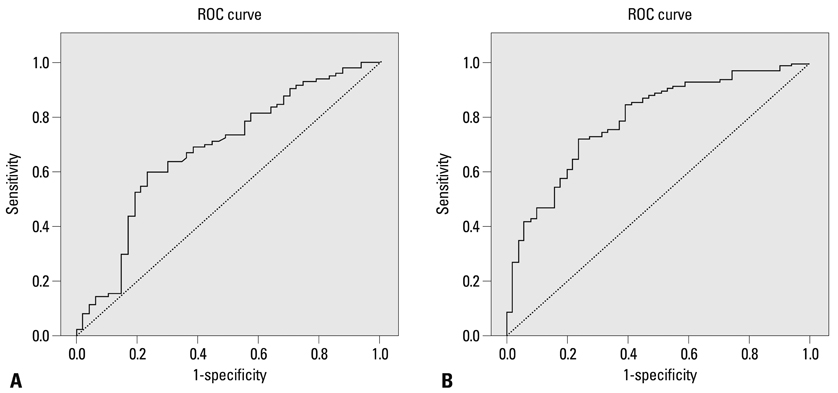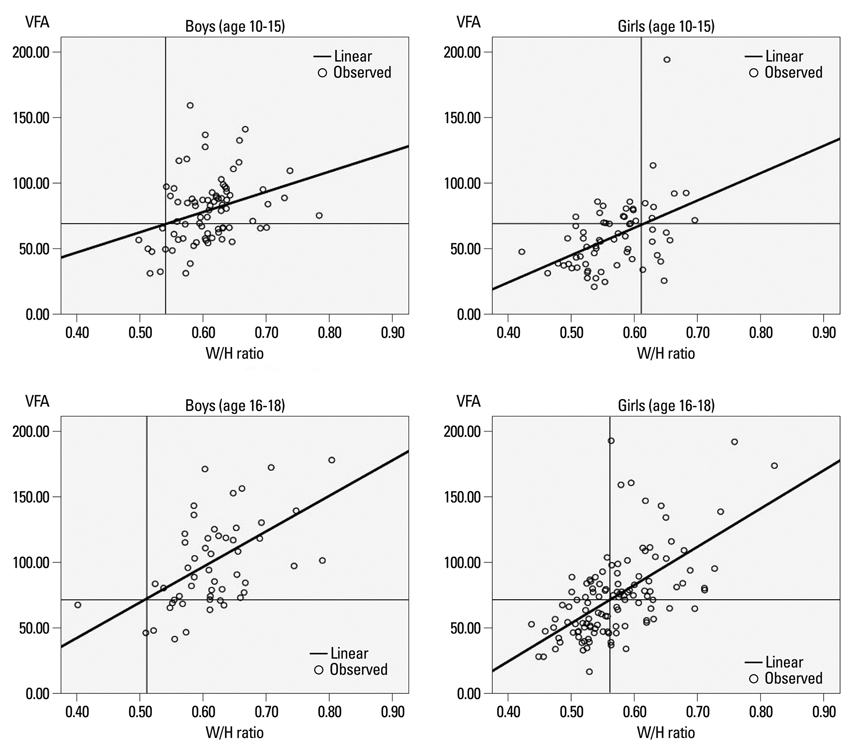Yonsei Med J.
2012 Jan;53(1):99-105. 10.3349/ymj.2012.53.1.99.
Cut-Off Values of Visceral Fat Area and Waist-to-Height Ratio: Diagnostic Criteria for Obesity-Related Disorders in Korean Children and Adolescents
- Affiliations
-
- 1Department of Family Medicine, The Catholic University of Korea School of Medicine, Uijeongbu St. Mary's Hospital, Uijeongbu, Korea. yks6303@catholic.ac.kr
- 2Department of Family Medicine, University of Ulsan College of Medicine, Asan Medical Center, Seoul, Korea.
- KMID: 1779692
- DOI: http://doi.org/10.3349/ymj.2012.53.1.99
Abstract
- PURPOSE
The aim of this study was to study the appropriate cut-off value of visceral fat area (VFA) and waist-to-height ratio (WTHR) which increase the risk of obesity-related disorders and to validate the diagnostic criteria of abdominal obesity and metabolic syndrome in Korean children and adolescents.
MATERIALS AND METHODS
A total 314 subjects (131 boys and 183 girls) were included in this study. The subjects were selected from Korean children and adolescents who visited three University hospitals in Seoul and Uijeongbu from January 1999 to December 2009. All patients underwent computed tomography to measure VFA.
RESULTS
The cut-off value of VFA associated with an increase risk of obesity-related disorder, according to the receiver operating characteristics curve, was 68.57 cm2 (sensitivity 59.8%, specificity 76.6%, p=0.01) for age between 10 to 15 years, and 71.10 cm2 (sensitivity 72.3%, specificity 76.5%, p<0.001) for age between 16 to 18 years. By simple regression analysis, the WTHR corresponding to a VFA of 68.57 cm2 was 0.54 for boys and 0.61 for girls, and the WTHR corresponding to a VFA of 71.10 cm2 was 0.51 for boys and 0.56 for girls (p=0.004 for boys, p<0.001 for girls).
CONCLUSION
Based on the results of this study, VFA which increases the risk of obesity-related disorders was 68.57 cm2 and the WTHR corresponding to this VFA was 0.54 for boys and 0.61 for girls age between 10-15 years, 71.70 cm2 and the WTHR 0.51 for boys and 0.56 for girls age between 16-18 years. For appropriate diagnostic criteria of abdominal obesity and obesity-related disorders in Korean children and adolescents, further studies are required.
MeSH Terms
Figure
Reference
-
1. Flegal KM, Carroll MD, Ogden CL, Johnson CL. Prevalence and trends in obesity among US adults, 1999-2000. JAMA. 2002. 288:1723–1727.
Article2. Reilly JJ, Dorosty AR. Epidemic of obesity in UK children. Lancet. 1999. 354:1874–1875.
Article3. Daniels SR, Morrison JA, Sprecher DL, Khoury P, Kimball TR. Association of body fat distribution and cardiovascular risk factors in children and adolescents. Circulation. 1999. 99:541–545.
Article4. Dalton M, Cameron AJ, Zimmet PZ, Shaw JE, Jolley D, Dunstan DW, et al. Waist circumference, waist-hip ratio and body mass index and their correlation with cardiovascular disease risk factors in Australian adults. J Intern Med. 2003. 254:555–563.
Article5. Pouliot MC, Després JP, Lemieux S, Moorjani S, Bouchard C, Tremblay A, et al. Waist circumference and abdominal sagittal diameter: best simple anthropometric indexes of abdominal visceral adipose tissue accumulation and related cardiovascular risk in men and women. Am J Cardiol. 1994. 73:460–468.
Article6. Després JP, Nadeau A, Tremblay A, Ferland M, Moorjani S, Lupien PJ, et al. Role of deep abdominal fat in the association between regional adipose tissue distribution and glucose tolerance in obese women. Diabetes. 1989. 38:304–309.
Article7. Seidell JC, Oosterlee A, Deurenberg P, Hautvast JG, Ruijs JH. Abdominal fat depots measured with computed tomography: effects of degree of obesity, sex, and age. Eur J Clin Nutr. 1988. 42:805–815.8. Examination Committee of Criteria for 'Obesity Disease' in Japan. Japan Society for the Study of Obesity. New criteria for 'obesity disease' in Japan. Circ J. 2002. 66:987–992.9. Kim JA, Choi CJ, Yum KS. Cut-off values of visceral fat area and waist circumference: diagnostic criteria for abdominal obesity in a Korean population. J Korean Med Sci. 2006. 21:1048–1053.
Article10. Alberti KG, Zimmet P, Shaw J. IDF Epidemiology Task Force Consensus Group. The metabolic syndrome--a new worldwide definition. Lancet. 2005. 366:1059–1062.
Article11. Savva SC, Tornaritis M, Savva ME, Kourides Y, Panagi A, Silikiotou N, et al. Waist circumference and waist-to-height ratio are better predictors of cardiovascular disease risk factors in children than body mass index. Int J Obes Relat Metab Disord. 2000. 24:1453–1458.
Article12. Weili Y, He B, Yao H, Dai J, Cui J, Ge D, et al. Waist-to-height ratio is an accurate and easier index for evaluating obesity in children and adolescents. Obesity (Silver Spring). 2007. 15:748–752.
Article13. Grundy SM, Cleeman JI, Daniels SR, Donato KA, Eckel RH, Franklin BA, et al. Diagnosis and management of the metabolic syndrome: an American Heart Association/National Heart, Lung, and Blood Institute Scientific Statement. Circulation. 2005. 112:2735–2752.14. Kim JA, Park HS. Association of abdominal fat distribution and cardiometabolic risk factors among obese Korean adolescents. Diabetes Metab. 2008. 34:126–130.
Article15. Reinehr T, Wunsch R. Relationships between cardiovascular risk profile, ultrasonographic measurement of intra-abdominal adipose tissue, and waist circumference in obese children. Clin Nutr. 2010. 29:24–30.
Article16. Hsieh SD, Yoshinaga H, Muto T. Waist-to-height ratio, a simple and practical index for assessing central fat distribution and metabolic risk in Japanese men and women. Int J Obes Relat Metab Disord. 2003. 27:610–616.
Article17. McCarthy HD, Cole TJ, Fry T, Jebb SA, Prentice AM. Body fat reference curves for children. Int J Obes (Lond). 2006. 30:598–602.
Article18. Guntsche Z, Guntsche EM, Saraví FD, Gonzalez LM, Lopez Avellaneda C, Ayub E, et al. Umbilical waist-to-height ratio and trunk fat mass index (DXA) as markers of central adiposity and insulin resistance in Argentinean children with a family history of metabolic syndrome. J Pediatr Endocrinol Metab. 2010. 23:245–256.
Article19. Miranda PJ, DeFronzo RA, Califf RM, Guyton JR. Metabolic syndrome: definition, pathophysiology, and mechanisms. Am Heart J. 2005. 149:33–45.
Article
- Full Text Links
- Actions
-
Cited
- CITED
-
- Close
- Share
- Similar articles
-
- Cut-off Value of Visceral Fat Area at Risk of Obesity-related Disorders in Korean Adult Population
- Cut-off Values of Visceral Fat Area and Waist Circumference: Diagnostic Criteria for Abdominal Obesity in a Korean Population
- Influence of Waist Circumference Measurement Site on Visceral Fat and Metabolic Risk in Youth
- The correlation between simple anthropometric indices and abdominal visceral fat accumulation by computed tomography
- The Association of Visceral Fat Area with Anthropometric Variables and its Risk for Metabolic Syndrome



